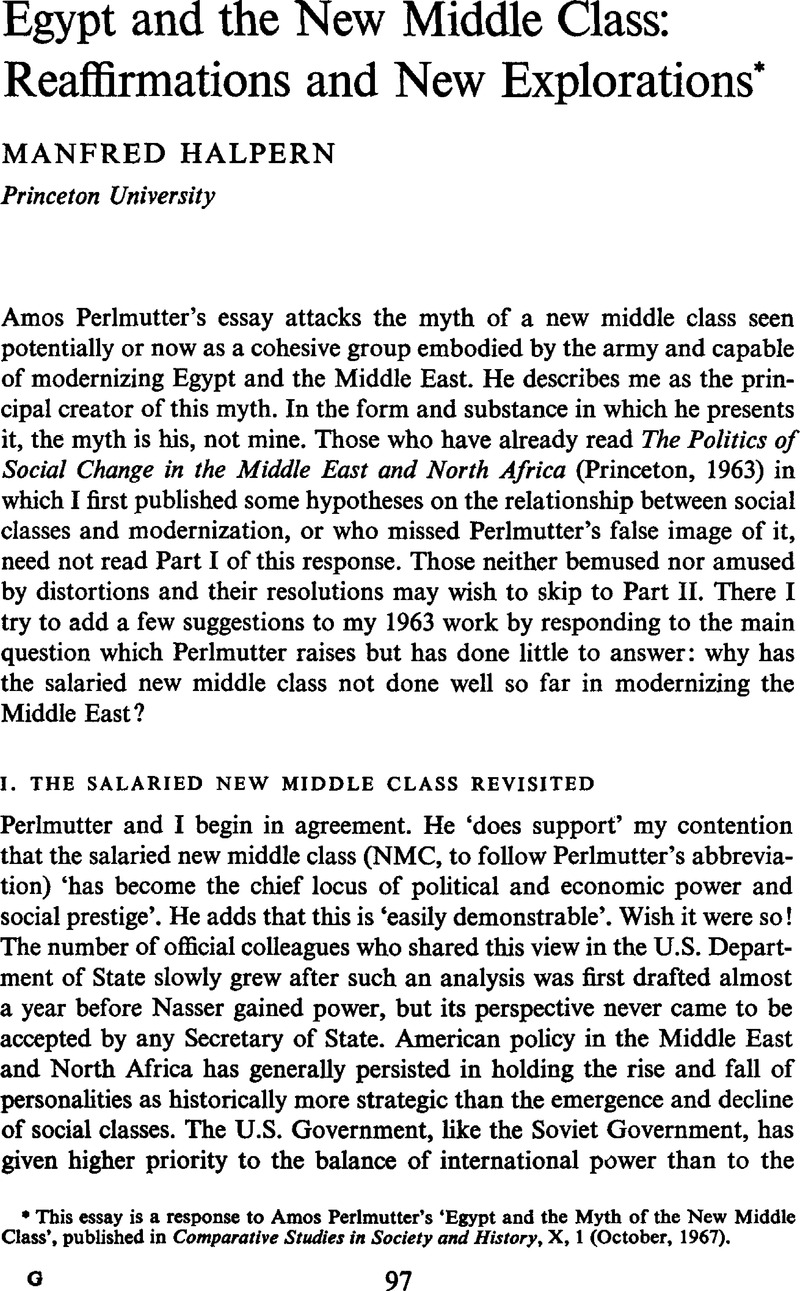Article contents
Egypt and the New Middle Class: Reaffirmations and New Explorations*
Published online by Cambridge University Press: 03 June 2009
Abstract

- Type
- Debate
- Information
- Copyright
- Copyright © Society for the Comparative Study of Society and History 1969
References
page 98 note 1 The conservative scholarly position, however, was also being reiterated during this period. First in a series of lectures as Visiting Professor of Sociology of the Middle East at the University of California at Los Angeles in 1961–62, and subsequently in a book published in 1965, Professor C. A. O. van Nieuwenhuijze challenged the various newer interpretations presented by Morroe Berger and H. al-Sa'aty as ‘premature’. ‘Clearly important changes are taking place. But as yet, they do not add up to a development in the sense that one could already distinguish [the makings of] a middle class as part of an encompassing stratification pattern in a fundamentally integrative rather than composite society.’ Instead van Nieuwen-huijze believes that each of the various ‘effendi’ categories, among them officials, officers, educators, and engineers, will ‘for quite some time to come’ be ‘rated somewhere in the middle brackets of a vague, flexible, variable social scale that eludes description insofar as its overall consistency would be concerned. … It may thus be wise to count with the possibility that, notwithstanding some important changes in sectors of society that would reflect in the rating of categories, the traditional structure of ruling elite plus broad masses, enriched with some in-between entities of secondary nature, would persist.’ (C. A. O. van Nieuwehnuijze, Social Stratification and the Middle East, Leiden, E. J. Brill, 1965, pp. 27, 25, and 78.)
page 99 note 1 The Politics of Social Change in the Middle East and North Africa, pp. 62–3; 66–7, note 21; p. 54, note 4.Google Scholar
page 99 note 2 Ibid., p. 55, note 4.
page 100 note 1 Ibid., p. 51.
page 100 note 2 Ibid., p. 56; see also p. 59, note 10.
page 101 note 1 Ibid., pp. 61–2.
page 102 note 1 have more recently turned to a different and I think better conception of ‘modernization’ which is explored in the second part of this essay. In terms of creating a modernizing political culture, however, the original statement remains adequate.
page 103 note 1 Op. cit., p. 59. Developments in Turkey and Iran since 1963 suggest that the propertied middle class is growing in economic, social and political importance more so than elsewhere in the Islamic Middle East but without utilizing its power deliberately to overcome the growing incoherences in these societies.
page 103 note 2 Ibid., p. 364.
page 105 note 1 In The Dialectics of Modernization in National and International Society, I also speak of the advantages and disadvantages of utilizing several other polarities once unconsciously employed in Islam as instruments for the genesis of modernization. For example, in the Polarity of Emanation (to simplify the point), one individual relates to the other as an exten-sion of the other's personality. In the pre-modern era, the Polarity of Emanation was mani-fested frequently in crises which, if endemic, were also discontinuous and familiar, and required the transformation of a few and not the persistent transformation of the many. Now Emanation is intended to embody and produce both unity in permanent crisis and also the new and chang-ing model of modernizing man. To persist in the deliberate transformation of men now in the throes of varying and largely unintended forces of change through covert manipulation, and emergent or routinized charisma has proved a much harder task. Though Muslims are still tempted to rely upon particular leading persons, modernization is a transformation of society that requires the sustained commitment of at least one social class.
page 106 note 1 The Polarity of Boundary-Management is also manifested by behavior in several pre-modern and non-Western societies, for example, among peasants in Thailand. While I confine the present discussion to specific manifestations of that polarity in the modern West, my argument that these are insufficient for modernization may be generalized to apply to any behavioral manifestation of the Polarity of Boundary-Management anywhere and at any time.
page 107 note 1 For a brilliant and detailed demonstration of the contrasts between styles of relationship abstracted in the present paper as Boundary-Management and Transformation, see Crozier, Miche, The Bureaucratic Phenomenon, Chicago, 1964.Google Scholar
page 107 note 2 In The Dialectics of Modernization, I have attempted to clarify the crucial components of freedom and participation required for persistent transformation. Here I mean to clarify only the unintended results of applying conventional ideals of ‘competition’ to the contempor- ary Middle East.
- 7
- Cited by


